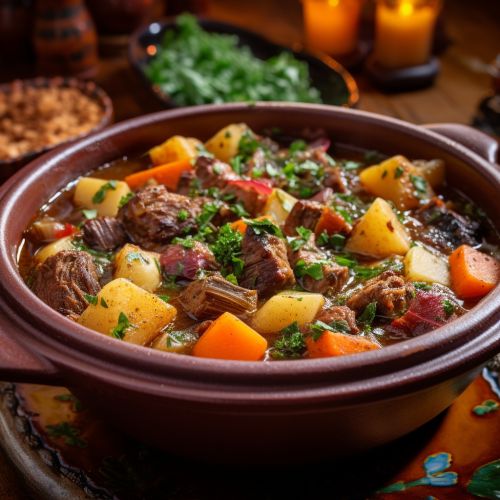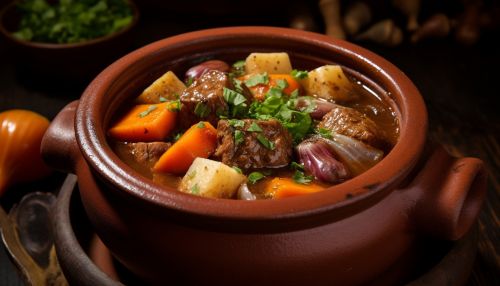Stews
Introduction
Stews are a type of culinary dish characterized by slow cooking in liquid, typically water or stock. They are a universal dish, found in nearly every culture's cuisine around the world. Stews are often made with tougher cuts of meat that become tender and flavorful after long periods of simmering. The dish is known for its hearty and comforting qualities, making it a staple in many homes, especially during colder months.


History
The history of stews is as old as the discovery of fire and the invention of pottery. The earliest evidence of stews dates back to the Neolithic Age, when ancient humans began using unglazed pottery to cook food. The slow cooking process allowed for the breakdown of tough fibers in meat, making it easier to eat and digest. This method of cooking also preserved the nutrients in the food, making stews a nutritious meal option.
Types of Stews
There are countless types of stews, each with its own unique combination of ingredients and flavors. Some of the most well-known types include:
Beef Stew
Beef stew is a classic dish made with chunks of beef, vegetables such as carrots, potatoes, and onions, and a rich beef broth. It is often flavored with herbs and spices like thyme, bay leaves, and black pepper.
Chicken Stew
Chicken stew is a versatile dish that can be prepared in many different ways. It typically includes chicken, vegetables, and a flavorful broth. Some variations may also include rice or noodles.
Fish Stew
Fish stew, also known as seafood stew, is a dish made with various types of seafood, such as fish, shellfish, and sometimes even seaweed. It is often flavored with herbs, spices, and sometimes wine.
Vegetable Stew
Vegetable stew is a vegetarian or vegan dish made with a variety of vegetables. It can be flavored with a wide range of herbs and spices, and sometimes includes legumes or grains for added protein.
Cooking Techniques
While the basic technique for making stew involves slow cooking in liquid, there are several variations on this method. Some of these include:
Braising
Braising is a technique that involves searing meat at high heat before simmering it in liquid. This method is often used in beef stew to enhance the flavor and texture of the meat.
Slow Cooking
Slow cooking is a method that involves cooking food at a low temperature for a long period of time. This technique is often used in stews to tenderize meat and develop deep, complex flavors.
Pressure Cooking
Pressure cooking is a method that involves cooking food under high pressure, which significantly reduces the cooking time. This technique is often used in stews to quickly tenderize meat and vegetables.
Cultural Variations
Stews are a global dish, with each culture adding its own unique twist. Some notable examples include:
Irish Stew
Irish stew is a traditional dish in Ireland made with lamb or mutton, potatoes, onions, and parsley. It is known for its simplicity and hearty flavor.
Goulash
Goulash is a Hungarian stew made with beef, onions, and paprika. It is typically served with noodles or dumplings.
Bouillabaisse
Bouillabaisse is a French seafood stew made with various types of fish and shellfish, saffron, and olive oil. It is typically served with a side of rouille, a spicy garlic sauce.
Health Benefits
Stews are not only delicious, but they can also be quite nutritious. They are often high in protein, fiber, and vitamins and minerals from the meat and vegetables. Additionally, the slow cooking process can help to break down tough fibers in meat, making it easier to digest and absorb the nutrients.
Conclusion
Stews are a beloved dish around the world, known for their comforting qualities and deep, complex flavors. Whether it's a classic beef stew, a spicy goulash, or a hearty vegetable stew, there's a stew for every palate and occasion.
